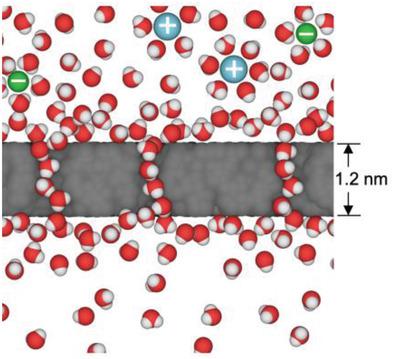当前位置:
X-MOL 学术
›
Adv. Mater.
›
论文详情
Our official English website, www.x-mol.net, welcomes your
feedback! (Note: you will need to create a separate account there.)
Ultrahigh Ionic Exclusion through Carbon Nanomembranes.
Advanced Materials ( IF 27.4 ) Pub Date : 2020-01-16 , DOI: 10.1002/adma.201907850 Yang Yang 1, 2 , Roland Hillmann 1 , Yubo Qi 1 , Riko Korzetz 1 , Niklas Biere 1 , Daniel Emmrich 1 , Michael Westphal 1 , Björn Büker 1 , Andreas Hütten 1 , André Beyer 1 , Dario Anselmetti 1 , Armin Gölzhäuser 1
Advanced Materials ( IF 27.4 ) Pub Date : 2020-01-16 , DOI: 10.1002/adma.201907850 Yang Yang 1, 2 , Roland Hillmann 1 , Yubo Qi 1 , Riko Korzetz 1 , Niklas Biere 1 , Daniel Emmrich 1 , Michael Westphal 1 , Björn Büker 1 , Andreas Hütten 1 , André Beyer 1 , Dario Anselmetti 1 , Armin Gölzhäuser 1
Affiliation

|
The collective "single-file" motion of water molecules through natural and artificial nanoconduits inspires the development of high-performance membranes for water separation. However, a material that contains a large number of pores combining rapid water flow with superior ion rejection is still highly desirable. Here, a 1.2 nm thick carbon nanomembrane (CNM) made from cross-linking of terphenylthiol (TPT) self-assembled monolayers is reported to possess these properties. Utilizing their extremely high pore density of 1 sub-nm channel nm-2 , TPT CNMs let water molecules rapidly pass, while the translocation of ions, including protons, is efficiently hindered. Their membrane resistance reaches ≈104 Ω cm2 in 1 m Cl- solutions, comparable to lipid bilayers of a cell membrane. Consequently, a single CNM channel yields an ≈108 higher resistance than pores in lipid membrane channels and carbon nanotubes. The ultrahigh ionic exclusion by CNMs is likely dominated by a steric hindrance mechanism, coupled with electrostatic repulsion and entrance effects. The operation of TPT CNM membrane composites in forward osmosis is also demonstrated. These observations highlight the potential of utilizing CNMs for water purification and opens up a simple avenue to creating 2D membranes through molecular self-assembly for highly selective and fast separations.
中文翻译:

通过碳纳米膜的超高离子排斥。
水分子通过天然和人工纳米管道的集体“单文件”运动激发了用于水分离的高性能膜的开发。然而,仍然非常需要包含大量孔的材料,其结合了快速的水流和优异的离子排斥性。在此,据报道由三联苯硫醇(TPT)自组装单层的交联制成的1.2 nm厚的碳纳米膜(CNM)具有这些特性。TPT CNM利用其1亚纳米通道nm-2的极高孔隙密度,使水分子迅速通过,同时有效地阻止了包括质子在内的离子易位。在1 m Cl-溶液中,它们的膜电阻达到≈104Ωcm2,与细胞膜的脂质双层相当。所以,单个CNM通道产生的阻力比脂质膜通道和碳纳米管中的孔高≈108。CNM的超高离子排斥可能是由位阻机制,以及静电排斥和进入效应所决定的。还展示了TPT CNM膜复合材料在正向渗透中的操作。这些观察结果突出了利用CNM进行水净化的潜力,并为通过分子自组装产生2D膜提供了一条简单的途径,以实现高度选择性和快速分离。还展示了TPT CNM膜复合材料在正向渗透中的操作。这些观察结果突出了利用CNM进行水净化的潜力,并为通过分子自组装产生2D膜提供了一条简单的途径,以实现高度选择性和快速分离。还展示了TPT CNM膜复合材料在正向渗透中的操作。这些观察结果突出了利用CNM进行水净化的潜力,并为通过分子自组装产生2D膜提供了一条简单的途径,以实现高度选择性和快速分离。
更新日期:2020-02-24
中文翻译:

通过碳纳米膜的超高离子排斥。
水分子通过天然和人工纳米管道的集体“单文件”运动激发了用于水分离的高性能膜的开发。然而,仍然非常需要包含大量孔的材料,其结合了快速的水流和优异的离子排斥性。在此,据报道由三联苯硫醇(TPT)自组装单层的交联制成的1.2 nm厚的碳纳米膜(CNM)具有这些特性。TPT CNM利用其1亚纳米通道nm-2的极高孔隙密度,使水分子迅速通过,同时有效地阻止了包括质子在内的离子易位。在1 m Cl-溶液中,它们的膜电阻达到≈104Ωcm2,与细胞膜的脂质双层相当。所以,单个CNM通道产生的阻力比脂质膜通道和碳纳米管中的孔高≈108。CNM的超高离子排斥可能是由位阻机制,以及静电排斥和进入效应所决定的。还展示了TPT CNM膜复合材料在正向渗透中的操作。这些观察结果突出了利用CNM进行水净化的潜力,并为通过分子自组装产生2D膜提供了一条简单的途径,以实现高度选择性和快速分离。还展示了TPT CNM膜复合材料在正向渗透中的操作。这些观察结果突出了利用CNM进行水净化的潜力,并为通过分子自组装产生2D膜提供了一条简单的途径,以实现高度选择性和快速分离。还展示了TPT CNM膜复合材料在正向渗透中的操作。这些观察结果突出了利用CNM进行水净化的潜力,并为通过分子自组装产生2D膜提供了一条简单的途径,以实现高度选择性和快速分离。











































 京公网安备 11010802027423号
京公网安备 11010802027423号